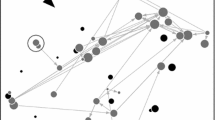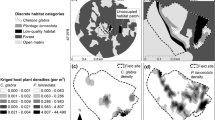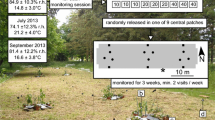Abstract
Individual movement is a key process affecting the distribution of animals in heterogeneous landscapes. For specialist species in patchy habitat, a central issue is how dispersal distances are related to landscape structure. We compared dispersal distances for cactus bugs (Chelinidea vittiger) on two naturally fragmented landscapes (≤ 4% suitable habitat) with different matrix structures (i.e., vegetation height of nonsuitable habitat between suitable patches). Using mark-release-recapture studies, we determined that most transfers between cactus patches occurred during the mating season. Dispersal distances were reduced by > 50% on the landscape that had reduced structural connectivity due to relatively high matrix structure and low patch density. An experiment with detailed movement pathways demonstrated that greater matrix structure decreased mean step lengths, reduced directionality, and thus decreased net displacement by > 60%. However, habitat edges between two matrix elements that differed substantially in resistance to movement were completely permeable. Therefore, the difference in distributions of dispersal distances between the two landscapes mainly reflected the average resistance of matrix habitat and not the level of matrix heterogeneity per se. Our study highlights the merits of combining estimates of dispersal distances with insights on mechanisms from detailed movement pathways, and emphasizes the difficulty of treating dispersal distances of species as fixed traits independent of landscape structure.
Similar content being viewed by others
References
Åberg J., Jansson G., Swenson J.E. and Angelstam P. 1995. The effect of matrix on the occurrence of hazel grouse (Bonasa bonasia) in isolated habitat fragments. Oecologia 103: 265–269.
Baker M., Nur N. and Geupel G.R. 1995. Correcting biased estimates of dispersal and survival due to limited study area: theory and an application using wrentits. The Condor 97: 663–674.
Batschelet E. 1981. Circular statistics in biology. Academic Press, London, UK.
Collinge S.K. and Palmer T.M. 2002. The influence of patch shape and boundary contrast on insect response to fragmentation in California grasslands. Landscape Ecology 17: 647–656.
Conover W.J. 1980. Practical nonparametric statistics. John Wiley & Sons, New York, New York, USA.
De Vol J.E. and Goeden R.D. 1973. Biology of Chelinidea vittiger with notes on its host-plant relationships and value in biological weed control. Environmental Entomology 2: 231–240.
Dodd A.P. 1940. The biological campaign against prickly-pear. Commonwealth Prickly Pear Board, Brisbane, Australia.
Dooley Jr. J.L. and Bowers M.A. 1998. Demographic responses to habitat fragmentation: empirical tests at the landscape and patch scale. Ecology 79: 969–980.
Goodwin B.J. and L. Fahrig. 2002a. How does landscape structure influence landscape connectivity? Oikos 99: 552–5700.
Goodwin B.J. and L. Fahrig. 2002b. Effect of landscape structure on the movement behaviour of a specialized goldenrod beetle, Trirhabda borealis. Canadian Journal of Zoology 80: 24–35.
Haddad N.M. 1999. Corridor use predicted from behaviors at habitat boundaries.American Naturalist 153: 215–2277.
Hamlin J.C. 1924. A review of the genus Chelinidea (Hemiptera-Heteroptera with biological data. Annals Entomological Society of America 17: 193–2088.
Hanski I. 2001. Population dynamic consequences of dispersal in local populations and in metapopulations. In: Clobert J., Danchin E., Dhondt A.A. and Nichols J.D. (eds), Dispersal, pp. 283–298. Oxford University Press, Oxford, UK.
Hargrove W.H. and Pickering J. 1992. Pseudoreplication: a sine qua non for regional ecology. Landscape Ecology 6: 251–258.
Harrison S. and Taylor A.D. 1997. Empirical evidence for metapopulation dynamics. In: Hanski I.A. and Gilpin M.E. (eds), Metapopulation biology: ecology, genetics, and evolution, pp. 27–42. Academic Press, San Diego, California, USA.
Ims R.A. and Yoccoz N.G. 1997. Studying transfer processes in metapopulations: emigration, migration, and colonization. In: Hanski I.A. and Gilpin M.E. (eds), Metapopulation biology: ecology, genetics, and evolution, pp. 247–265. Academic Press, San Diego, California, USA.
Joly P., Miaud C., Lehmann A. and Grolet O. 2001. Habitat matrix effects on pond occupancy in newts. Conservation Biology 15: 239–248.
Jonsen I.D., Bourchier R.S. and Roland J. 2001. The influence of matrix habitat on Aphthona flea beetle immigration to leafy spurge patches. Oecologia 127: 287–2944.
Kindvall O. 1999. Dispersal in a metapopulation of the bush cricket, Metrioptera bicolor (Orthoptera:Tettigoniidae). Journal of Animal Ecology 68: 172–1855.
Koenig W.D., Hooge P.N., Stanback M.T. and Haydock J. 2000. Natal dispersal in the cooperatively breeding acorn woodpecker. The Condor 102: 492–502.
Kuussaari M., Nieminen M. and Hanski I. 1996. An experimental study of migration in the Glanville fritillary butterfly Melitaea cinxia. Journal of Animal Ecology 65: 791–801.
Lima S.L. and Zollner P.A. 1996. Towards a behavioral ecology of ecological landscapes. Trends in Ecology and Evolution 11: 131–135.
Mann J. 1969. Cactus-feeding insects and mites. United States National Museum Bulletin 256, Smithsonian Institution Press, Washington, DC, USA.
Matthysen E., Adriaensen F. and Dhondt A.A. 1995. Dispersal distances of nuthatches, Sitta europaea, in a highly fragmented forest habitat. Oikos 72: 375–381.
Mennechez G., Schtickzelle N. and Baguette M. 2003. Metapopulation dynamics of the bog fritillary butterfly: comparison of demographic parameters and dispersal between a continuous and a highly fragmented landscape. Landscape Ecology 18: 279–291.
Morales J.M. 2002. Behavior at habitat boundaries can produce leptokurtic movement distributions. American Naturalist 160: 531–538.
Oksanen L. 2001. Logic of experiments in ecology: is pseudoreplication a pseudoissue? Oikos 94: 27–38.
Petit S. and Burel F. 1998. Effects of landscape dynamics on the metapopulation of a ground beetle (Coleoptera: Carabidae) in a hedgerow network. Agriculture, Ecosystems and Environment 69: 243–252.
Pither J. and Taylor P.D. 1998. An experimental assessment of landscape connectivity. Oikos 83: 166–174.
Ricketts T.H. 2001. The matrix matters: effective isolation in fragmented landscapes. The American Naturalist 158: 87–999.
Ries L. and Debinski D.M. 2001. Butterfly responses to habitat edges in the highly fragmented prairies of central Iowa. Journal of Animal Ecology 70: 840–852.
Roland J., Keyghobadi N. and Fownes S. 2000. Alpine Parnassius butterfly dispersal: effects of landscape and population size. Ecology 81: 1642–1653.
Schneider C. 2003. The influence of spatial scale on quantifying insect dispersal: an analysis of butterfly data. Ecological Entomology 28: 252–256.
Schooley R.L. 2002. Spatial ecology of cactus bugs: interactions among suitable habitat, connectivity, and movements. PhD Dissertation. Colorado State University, Fort Collins, Colorado, USA, 153 pp.
Schooley R.L. and Wiens J.A. 2003. Finding habitat patches and directional connectivity. Oikos 102: 559–570.
Schtickzelle N. and Baguette M. 2003. Behavioural responses to habitat patch boundaries restrict dispersal and generate emigration-patch area relationships in fragmented landscapes. Journal of Animal Ecology 72: 533–545.
Schultz C.B. and Crone E.E. 2001. Edge-mediated dispersal behavior in a prairie butterfly. Ecology 82: 1879–1892.
Stamps J.A., Buechner M. and Krishnan V.V. 1987. The effects of edge permeability and habitat geometry on emigration from patches of habitat. American Naturalist 129: 533–552.
Taylor P.D., Fahrig L., Henein K. and Merriam G. 1993. Connectivity is a vital element of landscape structure. Oikos 68: 571–573.
Tischendorf L. and Fahrig L. 2000. On the usage and measurement of landscape connectivity. Oikos 90: 7–19.
Turchin P. 1998. Quantitative analysis of movement: measuring and modeling population redistribution in animals and plants. Sinauer Associates, Sunderland, Massachusetts, USA.
Vandermeer J., Hoffman B. Krantz-Ryan S.L., Wijayratne U., Buff J. and Franciscus V. 2001. Effect of habitat fragmentation on gypsy moth (Lymantria dispar L.) dispersal: the quality of the matrix. American Midland Naturalist 145: 188–193.
Wiens J.A. 2001. The landscape context of dispersal. In: Clobert J., Danchin E., Dhondt A.A. and Nichols J.D. (eds), Dispersal, pp. 96–109. Oxford University Press, Oxford, UK.
Wiens J.A., Crawford C.S. and Gosz J.R. 1985. Boundary dynamics: a conceptual framework for studying landscape ecosystems. Oikos 45: 421–427.
Wiens J.A., Crist T.O. and Milne B.T. 1993b. On quantifying insect movements. Environmental Entomology 22: 709–715.
Wiens J.A. and Milne B.T. 1989. Scaling of ‘landscapes’ in landscape ecology, or, landscape ecology from a beetle’s perspective. Landscape Ecology 3: 87–96.
Wiens J.A., Schooley R.L. and Weeks Jr. R.D. 1997. Patchy landscapes and animal movements: do beetles percolate? Oikos 78: 257–264.
Wiens J.A., Stenseth N.C., Van Horne B. and Ims R.A. 1993a. Ecological mechanisms and landscape ecology. Oikos 66: 369–380.
With K.A. and Crist T.O. 1995. Critical thresholds in species responses to landscape structure. Ecology 76: 2446–2459.
Wolff J.O., Schauber E.M. and Edge W.D. 1997. Effects of habitat loss and fragmentation on the behavior and demography of gray-tailed voles. Conservation Biology 11: 945–956.
Wratten S.D., Bowie M.H., Hickman J.M., Evans A.M., Sedcole J.R. and Tylianakis J.M. 2003. Field boundaries as barriers to movement of hover flies (Diptera: Syrphidae) in cultivated land. Oecologia 134: 605–611.
Author information
Authors and Affiliations
Corresponding author
Rights and permissions
About this article
Cite this article
Schooley, R.L., Wiens, J.A. Movements of cactus bugs: Patch transfers, matrix resistance, and edge permeability. Landscape Ecol 19, 801–810 (2004). https://doi.org/10.1007/s10980-005-0093-2
Received:
Accepted:
Issue Date:
DOI: https://doi.org/10.1007/s10980-005-0093-2




